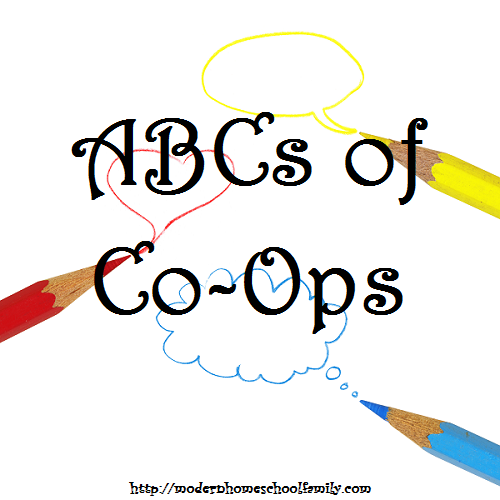A guest post by Jessica Hulcy.
I began experiencing the benefits associated with homeschool Co-Ops before I even knew what they were. Carole Thaxton prayed for someone to homeschool with, and God sent me as an answer to her prayer. Before I knew it, Carole had given me assignments and stated what she was going to do. That was “Co-Oping”—a group of parents sharing the responsibility of teaching their students. The information provided below is taken verbatim from the KONOS Compass and the KONOS DVD Creating the Balance, but it is germane to all units and all kinds of Co-Ops.
Benefits Galore
- Co-Ops give children the best, even when you are exhausted, by sharing teaching with other moms. Kids still get fabulous activities from one mom, while the other moms do errands or nap!
- Co-Ops allow children to benefit from the talents of other moms, and moms to benefit by receiving feedback on their children from other moms.
- Godly moms are not only fabulous role models for your kids but also serve as an intimate prayer support for all moms and kids.
- Groups offer ways to gain much more information. Instead of one report by one child on one tribe of Native American Indians, if there are eight kids in the Co-Op, then there can be eight reports on eight different tribes wearing eight different tribal costumes! This is the ultimate in reinforcing learning as kids see and hear again from other kids what they learned. Also, the many families provide an instant audience for all performances!
- Homeschoolers are often attacked by non-homeschoolers for isolating their children and depriving them of social peers with which to interact. Co-Oping solves that problem, but with the twist of parents get to pick the peers!
Guidelines for “Good Co-Oping”
Co-Ops are very much like marriages in that moms need to like the moms and kids need to like the kids in the Co-Op. No one is going to be perfect, but never start a Co-Op with moms just because they live near you and your kids are in the same grade. Past liking each other, solid Co-Oping happens when the moms share the same spiritual, emotional, and academic vision for their kids. Without a shared vision, you are beginning a relationship unequally yoked. Once you have chosen your Co-Op partners, the group can establish goals and workload. What you do not want is for moms to have divergent goals about what constitutes a “good Co-Op day,” e.g., one mother wants a play day while another mother plans for kids to video an interview with a Holocaust survivor and a WWII war veteran, tour the Holocaust museum, and write a first-person report as a survivor or as a soldier using what they learned from the interviews. Those are very different goals! Remember: If you exceed twelve children in your Co-Op, you have forfeited the tutorial method of teaching and moved into classroom method. The tutorial method of one-on-one instruction the type of education that was reserved for nobility in ancient days, as well as the method that has made homeschoolers test in the 80% on the average. I do not recommend abandoning the tutorial method for the sake of more help. On forming two smaller Co-Ops instead of one large one . . . It is best to group kids into readers and non-reader groups. That division helps immensely with activity instructions.
Policies Solve Potential Problems
The more you iron out before hand, the less wrinkles and tears you will have in the middle of the school year. General housekeeping questions concerning days, hours, carpools, lunches, dress, etc. need to be answered. In two or three summer meetings, those items can be addressed. Co-Ops can be weekly, twice a month, or monthly. My vote is for the regularity of weekly, and as long as you have taken dressed kids to someone else’s house, I vote for a full day of Co-Op. This is not a day of seatwork and reading that can be done independently at home. Co-Op day should be reserved for Barnum and Bailey activities that take time to organize and work better with a group. As long as you are getting eyeballs to dissect, you might as well pick up twelve of them! Discipline is always a concern when you take care of another person’s kids. Personally, I can work with a known felon—if I am in agreement with his authorities or parents about what my response should be and what their response to unruly behavior is going to be. With many families involved, be sensitive to money issues and dress issues. While one family may have expendable income for craft materials and field trips, another may not. Dress is also an issue. You don’t want Janey’s special dress ruined by paint, and you do not want the kids to go to the museum representing homeschoolers looking like ragamuffins. Communication is the key. Confucius says, “Faintest ink better than strongest memory.” Discussion that establishes agreed-upon, written policies before issues arise gives everyone policies to refer back to when issues arise, thereby putting the focus on established policies rather than on personalities. Above all else, add a covering of prayer for each other and each other’s children.
Jessica Hulcy, co-author of KONOS Curriculum, the first curriculum written for homeschool, is an educator, author, and formerly popular national homeschool speaker prior to her near-fatal wreck in 2009. A graduate of the University of Texas, mom to four grown sons, and “Grandear” to grandchildren, Jessica lives with her husband Wade on acreage in Texas. Recently Jessica and Wade started the ultimate online help for homeschooling moms called Homeschool Mentor. Visit www.homeschoolmentor.com and www.konos.com.
Copyright 2013, used with permission. All rights reserved by author. Originally appeared in the February 2013 issue of The Old Schoolhouse® Magazine, the family education magazine. Read the magazine free at www.TOSMagazine.com or read it on the go and download the free apps at www.TOSApps.com to read the magazine on your mobile devices.



